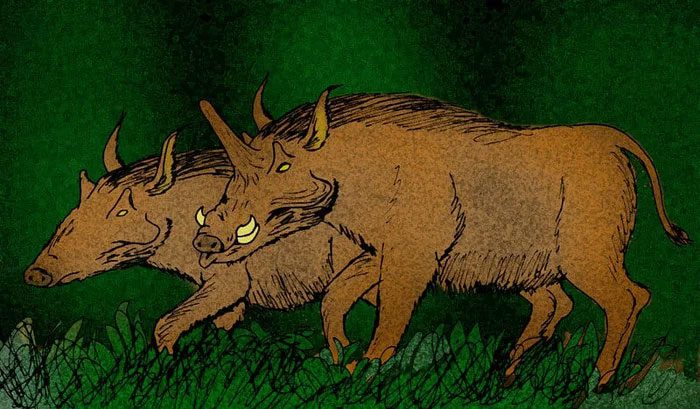Kubanochoerus gigas is an ancient pig species that lived in southern Russia and China. This species is named for the horn that grows from the middle of its forehead, leading to its nickname, the unicorn pig.
Fossils are the best tools for understanding extinct organisms. The earliest fossils of animals in the Suidae family date back to the Oligocene epoch, approximately 23-33 million years ago. The Suidae family includes wild boars, domestic pigs, and babirusas. About 16-18 species in the Suidae family are now extinct. The “unicorn pig,” now extinct, weighed nearly 500 kg and had a horn on its head, making it one of them.

The genera Libycochoerus and Megalocherus were once assigned to Kubanochoerus but are now considered distinct based on subtle details of teeth and skull.
Kubanochoerus is an extinct genus of long-legged pigs that lived from the early to mid-Miocene period. Kubanochoerus gigas is the largest species in this genus, standing about 3.3 feet tall and estimated to weigh around 1,100 pounds. The skull of Kubanochoerus features a large bony protrusion from the top of its head, along with two smaller horns emerging just above the eyebrows.
It is believed that only males possessed the unicorn-like horn on their heads. This animal had long legs and a robust body similar to many modern pig species.

The male of this species has a large horn on its forehead, which may have been used in battles with other males of the same species. The unicorn pig once inhabited what is now Russia and China, with adult individuals reaching weights of 500 kg and a shoulder height of 1.2 m.
The first fossils of Kubanochoerus were discovered in China in 1928. Initially, they were classified under the genus Listriodon. Kubanochoerus was first described in 1955. The classification of fossils within the Kubanochoerus genus has been a subject of considerable debate.
Fossils of this species have been found in China, Africa, and various Eurasian countries. A large skull fossil with a protrusion resembling a horn is one of the most significant discoveries aiding in the identification of Kubanochoerus gigas. Other fossils of teeth and lower jaws have also helped identify species within the genus.
A debate has persisted over whether the discovered fossils should be classified under the genera Libycochoerus, Megalocherus, or Kubanochoerus.

The species Kubanochoerus massai was initially thought to be an African species in this genus because the first specimen shared the distinctive brow horns characteristic of the genus. However, Kubanochoerus massai has recently been reclassified into its own genus, Libyochoerus.
Kubanochoerus gigas is the largest species in the genus, with other species including: Kubanochoerus lantianensis, Kubanochoerus mancharensis, Kubanochoerus minheensis, Kubanochoerus parvus, and Kubanochoerus robustus. The discovery of better-preserved fossils and more research in the future will help clarify the confusion surrounding this giant ancient pig species.
The largest Kubanochoerus species likely thrived in open habitats, as their size provided them protection. Smaller species may have lived in forested areas with dense canopies. This species likely inhabited open woodlands, grasslands, or a mix of both habitats. Kubanochoerus roamed across Eurasia and Africa from the Burdigalian to Tortonian stages of the Miocene.

They may have preyed on smaller animals they encountered or scavenged carcasses.
Modern pigs eat anything they encounter, and it is believed that the unicorn pig did the same. Meat may have been part of their diet. They might have preyed on smaller animals they encountered or scavenged on carcasses. The snout of the unicorn pig was not as adept at rooting as that of modern pigs due to its shorter nose.
Threats that Kubanochoerus faced in the wild may have included nimravids or saber-toothed cats, as well as bear dogs, which could have hunted this species if encountered.
This pig species also possessed tusks for self-defense, similar to modern pigs. While many large predators lived during the Miocene, Kubanochoerus may have used its tusks and large horn to compete better for food with other pig species.
Kubanochoerus gigas existed approximately 15-7 million years ago during the mid to late Miocene, with fossils known from a large portion of the Eurasian continent, including areas in both Georgia and China.
It is one of the largest known pig species to have ever lived, slightly larger than the modern giant wild boar, standing about 1.2 m at the shoulder. However, its most distinctive feature is a large horn growing from the center of its forehead, along with a smaller pair located just above the eyes, pointing forward on the forehead.
In archaeological discoveries, several specimens lacking the large horn have been found, leading some paleontologists to consider it a sexually dimorphic trait exclusive to males. However, it remains unclear if this is indeed the case, as at least one “hornless” skull has been reported with particularly larger tusks also associated with male pigs—suggesting that Kubanochoerus may have had both horned and hornless forms that could actually represent distinct species!


















































